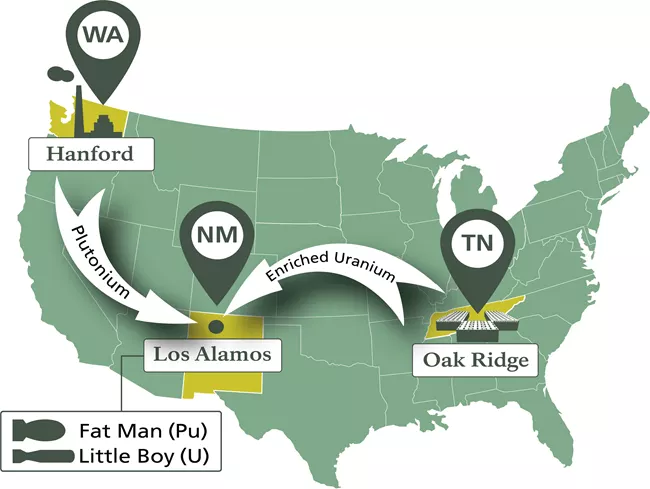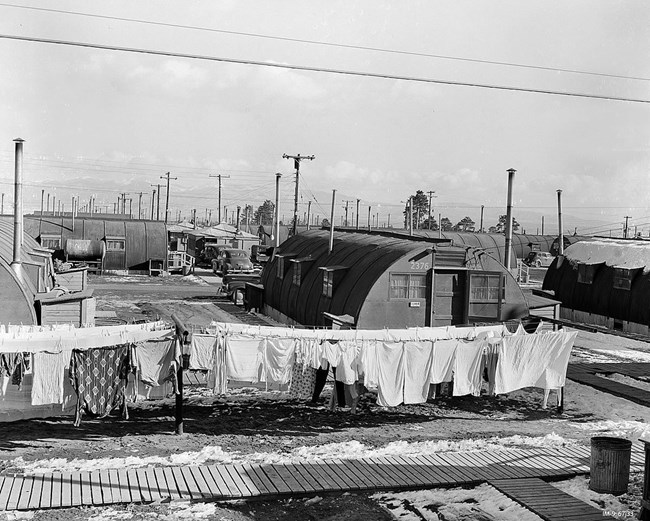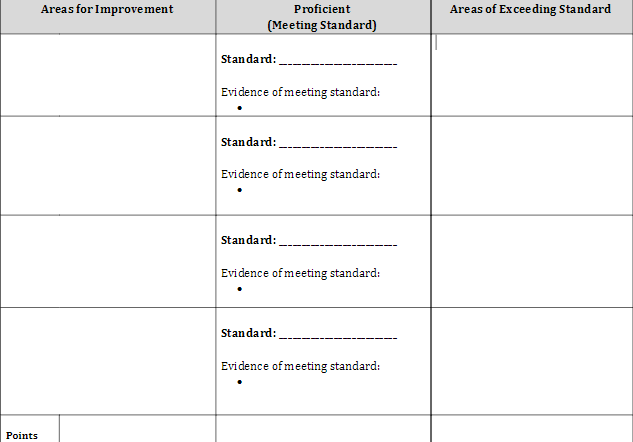Part of a series of articles titled Los Alamos County, NM, WWII Heritage City Lessons.
Article
(H)our History Lesson: Los Alamos County, New Mexico: Comparing and Connecting WWII Home Front Cities

National Park Service.
About this Lesson
This lesson is part of a series teaching about the World War II home front, with Los Alamos County, New Mexico designated as an American World War II Heritage City. The lesson contains photographs, a reading, and primary sources, with an optional activity, to contribute to learners’ understandings of the area as a WWII Heritage City. It combines lesson themes from the three other lessons in the collection to summarize the city’s contributions and encourage connections to the overall U.S. home front efforts.
To see more lessons about World War II, visit Teaching with Historic Places.
Objectives:
In a culminating product:
- Identify important World War II home front location(s) in Los Alamos County, New Mexico, and describe their historical significance
- Summarize the contributions of Los Alamos County civilians and service members to home front wartime efforts
- Evaluate the short- and long-term impacts of the contributions of the Los Alamos laboratories and The Manhattan Project
- Optional: Describe similarities and differences of Los Alamos County, NM and other Heritage city(s) / World War II home front(s), particularly those involved with the Manhattan Project.
Materials for Students:
- Photos 1 - 4
- Readings 1, 2, 3
- Maps, project materials (as needed)
- Optional Activity: Virtual Field trips (links)
- Student graphic organizers (See photo 5 at end of lesson, for reference)
- Create Comparison Matrices for your students to use. To compare two cities, create a one-page sheet with three columns and four rows. Label the left column "Theme/Topic" and the other columns "City 1" and "City 2." For a Comparison Matrix for three cities simply add an additional column.
- Create two Single-Point Rubrics to assist students’ self-assessment. One is for assessing proficiency in meeting teacher-selected standards. One is for assessing proficiency in meeting objectives.
- For the rubric on standards, create a one-page sheet with three columns and four rows of content. Label the first column “Areas for Improvement,” the second column, “Proficient (Meeting Standard),” and the third column, “Areas of Exceeding Standard.” Leave the first and third columns blank. In each row of the second column identify a Standard and indicate a space for noting the evidence for meeting the standard. Include a space at the bottom of the page for assigning points for each column.
- For the rubric on objectives, create a one-page sheet with three columns and four rows of content. Label the first column “Areas for Improving toward Objective,” the second column, “Proficient (Meeting Objective),” and the third column, “Areas of Exceeding Objective.” Leave the first and third columns blank. In the four rows of the second column identify these four objectives:
- Objective: Identify important World War II home front location(s) in Los Alamos County, New Mexico, and describe their historical significance
- Objective: Summarize the contributions of Los Alamos County civilians and service members to home front wartime efforts
- Objective: Evaluate the short- and long-term impacts of the contributions of the Los Alamos laboratories and The Manhattan Project
- Objective (Optional): Describe similarities and differences of Los Alamos County, NM and other Heritage city(s) / World War II home front(s), particularly those involved with the Manhattan Project.
Include a space at the bottom of the page for assigning points for each column.
Getting Started: Essential Question
Why was Los Alamos chosen as an American World War II Heritage City, and what are its similarities and differences to other home front cities?
Quotation to consider:
“An anonymous young scientist at Los Alamos, New Mexico, has in more serious vein summed up the whole issue in a few words that pack an awful wallop:
‘The war just ended,’ he says, is the last victory.’
‘If it is not the last war, it is the next-to-last war.’
Think that one over.”
“Atom Bomb Has Been Deadly Subject Right from the Very Start” by Peter Edson, The Whittier News (Whittier, California); November 9, 1945, p. 5
Reading to Connect
The Manhattan Project and Los Alamos (Overview)
By Sarah Nestor Lane
There are three American World War II Heritage Cities connected to the Manhattan Project: Los Alamos (New Mexico), Tri-Cities (Hanford, Washington), and Oak Ridge (Tennessee). Each had its own part in developing the atomic bombs.
The purpose of the Manhattan Project was to develop the first atomic bomb during World War II. It was a top-secret research project led by the United States, with the goal of building a powerful weapon before Germany or Japan could. The project aimed to harness the energy of nuclear reactions to create a devastating weapon that would help bring an end to the war.
The Los Alamos National Laboratory sites made important contributions to the Manhattan Project during World War II. The site was in Los Alamos County, in a desert, far away from everything, so they were able to secure the area, work without anyone finding out, and complete experiments. Hispanic ranchers and Native Americans were displaced from their homes and land there. Quickly constructed, large laboratory buildings were scattered along the south side of Ashley Pond. Rows of four-family apartments were built near the mountains. Some raised board sidewalks were made to prevent muddy conditions during winter snow melting and summer monsoons.
Workers lived in the county and traveled to their work sites. The site played a crucial role in developing and producing the atomic bomb. Plutonium from the Hanford site and uranium from Oak Ridge was used to develop two kinds of bombs at Los Alamos. One was called "Little Boy" and used uranium, and the other was called "Fat Man" and used plutonium. They evaluated two types of bombs: one was the gun method, where they used gun-like technology to bring together smaller amounts of material that wasn't quite enough to explode on its own, and the other was the implosion method. For the implosion method, they used explosives to squeeze a smaller amount of plutonium really tightly until it reached a point where it could cause a big explosion. Scientists combined materials in a way that created a chain reaction, where the splitting of one atom led to the splitting of more atoms, releasing a huge amount of energy.
Los Alamos not only worked on the science and building parts but also on the plans to put everything together. Finally, on July 16, 1945, they did a test with a bomb called the “Gadget,” called the Trinity Test. It was the first time a nuclear bomb was exploded. All the experiments and hard work in Los Alamos had culminated in this scientific milestone. Although an achievement for the scientists, the two bombs dropped on Japan resulted in thousands of Japanese civilians killed or suffered from injuries or exposure to radiation. With the atomic bombs completed and the war ending, the scientific community at Los Alamos faced a new chapter in history. It is still a national laboratory today.
“Scientist Believe Atomic Bomb May Cause Unending War”
LOS ALAMOS, N.M., Oct. 13. (AP)-- Ada Evening News (Ada, Oklahoma), October 14, 1945, p.1
Foreseeing atomic bombs “thousands of times more powerful” than those dropped on Japan, 400 scientists who developed the weapon at the government’s laboratory asserted in a statement today that to try to keep it from the rest of the world ‘will lead to an unending war more savage than the last.’
Released by Dr. Robert R. Wilson, member of the executive council, on behalf of the association of Los Alamos scientists, the statement said: It is certain that nations other than the United States, Great Britain and Canada by research can produce atomic power.
This nation’s highly concentrated industrial centers make it particularly vulnerable to such a weapon.
Counter-measures would be ‘extremely difficult and uncertain’ because of the ‘concentrated form of destructive energy’ and ‘the large number of possible methods of delivery.’
Advantage would lie with the aggressor. ‘A single heavy attack, lasting a matter of minutes, might destroy the ability of a nation to defend itself further.’ The bomb is ‘a deadly challenge to civilization itself.’
‘The use of atomic energy must be controlled by a world authority.’
The statement disapproved suggestions that the United States, Britain and Canada assume unilateral control over atomic power development.
‘Such a policy will lead to an unending war more savage than the last,’ the scientists said. ‘We can not conceive of it leading to a stable, peaceful world.’
‘We are convinced,’ the statement continued, ‘that we must cooperate with the rest of the world in the entire development of atomic power, and the use of atomic energy as a weapon must be controlled by a world authority.’
Expressing the belief that international control is technically feasible, the scientists said ‘abolition of secrecy in national and international relations may be necessary,’ providing free access to ‘all laboratories, industries and military installations.”
Excerpt from: “House Report 115-998
“To Direct the Secretary of the Interior to Annually Designate at Least One City in The United States as An ‘American World War II Heritage City,’ and for other purposes” (October 30, 2018)
“. . .PURPOSE OF THE BILL
The purpose of H.R. 6118 is to direct the Secretary of the Interior to annually designate at least one city in the United States as an ``American World War II Heritage City''.
BACKGROUND AND NEED FOR LEGISLATION
On December 7, 1941, military forces of the Empire of Japan attacked the U.S. Naval Fleet and ground bases at Pearl Harbor in Hawaii. On December 8, 1941, one day after what President Roosevelt referred to as, ``a date which will live in infamy,'' the United States declared war against the Empire of Japan. Three days later, on December 11, 1941, Japan's ally, Germany, declared war on the United States. Sixteen million Americans, mostly young working-age men, served in the military during World War II, out of an overall United States population of 113 million.
While an unprecedented number of Americans served in World War II, the country drastically increased its war production on the home front, serving not only the needs of the armed forces of the United States but her allies as well--in what President Franklin Roosevelt called ``The Arsenal of Democracy.'' The combination of millions serving in the military, during a period of necessary and drastic increases in production, led to significant social changes on the American home front.
The World War II period resulted in the largest number of people migrating within the United States in the history of the country. Individuals and families relocated to industrial centers for good paying jobs out of a sense of patriotic duty. Many industrial centers became ``boomtowns,'' growing at phenomenal rates. One example, the City of Richmond, California, grew from a population of under 24,000 to over 100,000 during the war. . . .”

Los Alamos National Laboratory
Student Activities:
Questions for Reading 1, Photos 1 & 2
- What was the main purpose of the Manhattan Project during World War II, and why was it considered a top-secret research project?
- How was the Los Alamos laboratory similar and different to Oak Ridge and Hanford?
- How did the Los Alamos National Laboratory contribute to the Manhattan Project's goal of creating atomic bombs, and what were the key scientific methods used to develop the bombs?
Questions for Reading 2, Photos 1 & 2
- What did the statement from the group of scientists at Los Alamos say about the possible outcome if atomic power is kept secret from other countries?
- How do the scientists explain why the United States is at risk because of its industrial centers when it comes to the use of atomic weapons by other countries?
- Assess the scientists' argument about having a worldwide authority controlling atomic power development. Consider the reasons they provide and the impact it might have on global stability, weighing both the benefits and challenges they mention in the statement.
Questions for Reading 3
- What was the purpose of the bill (H.R. 6118) according to the report?
- Why do you think Los Alamos, New Mexico was designated as a World War II Heritage City? Use details from the bill and from the lesson(s) information.
- Are there other cities you think of when considering home front contributions during wartime? Which, and why?
Optional Activity: Virtual Field Trips
Use virtual field trip videos to support comparisons among the Hanford, Los Alamos, and Oak Ridge sites. Learning from these can then be applied in the mastery product comparing two or more home front cities.
-
The Manhattan Project Field Trip - Oak Ridge and Los Alamos - (Produced by The National World War II Museum)
-
Oak Ridge Virtual Tour (Produced by American Museum of Science and Energy)
-
Ranger in your Pocket Virtual Tours (Produced by the Atomic Heritage Foundation)
-
You may also revisit videos used in other lessons, from The Manhattan Project National Historic Park

Courtesy of Sarah Nestor Lane
Culminating Activity/Mastery Product
To demonstrate student understanding, support students in creating a final product that meets the following objectives:
- Identify important World War II home front location(s) in Los Alamos County, New Mexico, and describe their historical significance
- Summarize the contributions of Los Alamos County civilians and service members to home front wartime efforts
- Evaluate the short- and long-term impacts of the contributions of the Los Alamos laboratories and The Manhattan Project
- Optional: Describe similarities and differences of Los Alamos County, NM and other Heritage city(s) / World War II home front(s), particularly those involved with the Manhattan Project.
Mastery products should be:
. . . student-led: Students work as individuals or in collaborative groups.
. . . student-directed: Students are offered a variety of choices for product type.
. . . student-organized: Teacher facilitates by providing students with the comparison matrices and/or resource links from throughout the series of lessons.
. . . student-assessed: Teacher supports student self-assessment and reflection by providing students single-point rubrics to assess for meeting standards and/or lesson objectives.
Note: Depending on time and scope, the comparison of Los Alamos to another WWII Heritage city(s) within the mastery product (objectives) may be omitted. However, comparing cities is recommended, as it connects students to a deeper understanding of the WWII home front.
Examples of mastery product choices include, but are not limited to:
-
Written: Letter (opinion or informative), essay, poem, narratives, biography, articles, class book or children’s book, speech or debate (then presented orally), blog / website, plaque or historical displays, pamphlets or rack cards
-
Graphic Organizers: timeline, flowcharts, mind or concept content maps, Venn diagrams, comparison matrices, posters
-
Artistic Expression: song, dance, theater (ex. skits), 3-D models, dioramas, photo journal, stamp and coin designs, visual art, architecture/building or monument, museum design
-
Media design and creation: podcast, historical markers, social media content, interactive virtual maps or tours, infographics, video, comic strips or graphics, game design, slideshows, digital scrapbook
Please view Teaching with Historic Place's World War II Page for information and resources on other cities.
This lesson was written by Sarah Nestor Lane, an educator and consultant with the Cultural Resources Office of Interpretation and Education, funded by the National Council on Public History's cooperative agreement with the National Park Service.
Tags
- world war ii
- world war 2
- wwii
- ww2
- world war ii home front
- wwii home front
- home front
- los alamos
- new mexico
- manhattan project
- manhattan project national historical park
- teaching with historic places
- twhp
- twhplp
- awwiihc
- american world war ii heritage city program
- military history
- military and wartime history
- atomic bomb
- nuclear weapons
- science and technology
- history of science
- women's history
- african american history
- native american history
- japan and the manhattan project
Last updated: April 7, 2025
